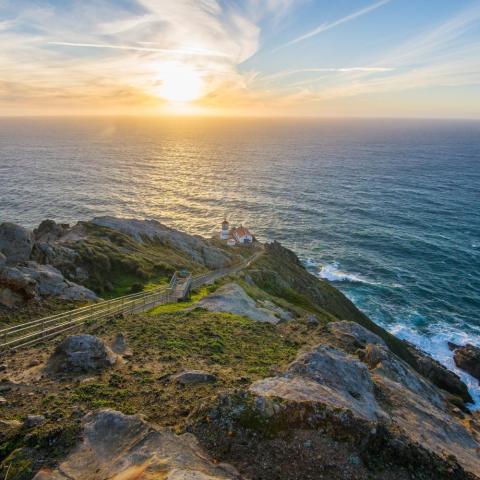
The last round of live mountain goat removal from Olympic National Park will begin Monday, followed by lethal removal this fall/NPS file
The last round of live mountain goat removal from Olympic National Park in Washington is scheduled to begin July 27, with lethal removal to begin in the fall.
The goats, non-native to the national park, are being moved to the northern Cascade Mountains to meet wildlife management goals in all three areas. Since September 2018, 275 mountain goats have been translocated.
This effort is a partnership between the National Park Service, the Washington Department of Fish & Wildlife, and the USDA Forest Service to re-establish and assist in connecting depleted populations of mountain goats in the Washington Cascades while also removing non-native goats from the Olympic Mountains. Mountain goats were introduced to the Olympics in the 1920s.
WDFW plans to release the mountain goats at 12 sites in the North Cascades national forests this round. Nine sites are in the Darrington, Preacher Mountain, Mt. Loop Highway, and Snoqualmie Pass areas of the Mt. Baker-Snoqualmie National Forest. Three release sites are in the Chikamin Ridge, Box Canyon, and Tower Mountain areas of Okanogan-Wenatchee National Forest.
“A project of this magnitude would be impossible without our partner agencies and the expertise and cooperation of hundreds of people,” said Olympic National Park Wildlife Branch Chief Dr. Patti Happe. “Because of this expertise and cooperation throughout the project, we anticipate reaching our objectives for capture and translocation in this final round.”
At the start of the translocation effort in 2018, the population of mountain goats was estimated at 725. Based on past removal efforts, it was estimated that approximately 50 percent of the mountain goat population, or 325-375 animals, could be safely captured over a total of four, two-week periods. To date, 275 mountain goats have been captured and translocated with a grand total of 326 removed from the population on the Olympic Peninsula.
Lethal removal will begin later this fall after this final round of capture and translocation.

Trail Impacts and Road Closures
The staging area for the mountain goat capture operation is located beyond the Hurricane Ridge Visitor Center in Olympic National Park along Hurricane Hill Road and is closed to public access.
Hurricane Hill Road is closed completely beyond the Hurricane Ridge Visitor Center through August 9 for mobilization, capture operations, and demobilization. This closure includes the Hurricane Hill Trail, Little River Trail, and Wolf Creek Trail. Hurricane Ridge Road and all other area trails remain open. A map of the area trails is available on the project website at nps.gov/olym/planyourvisit/mountain-goat-capture-and-translocation.htm.
No other closures will be in place for this project in Olympic National Park or the national forests.
Project Background
In May 2018, the NPS released the final Mountain Goat Management Plan, which outlined the effort to remove mountain goats on the Olympic Peninsula. Both the plan and the associated environmental impact statement were finalized after an extensive public review process which began in 2014.
“The mountain goat relocations not only augment resident populations, increasing population viability, but tracking the collared goats assists with our understanding of goats use of the habitat within the North Cascades” said Phyllis Reed, USFS wildlife biologist.
While some mountain goat populations in the north Cascades have recovered since the 1990s, the species is still absent from many areas of its historic range.
Aerial capture operations are conducted through a contract with Leading Edge Aviation, a private company that specializes in the capture and transport of wild animals. The helicopter crew uses immobilizing darts and net guns to capture mountain goats and transport them in specially-made slings to the staging areas.
The animals are cared for by veterinarians before WDFW wildlife managers transport them to staging areas in the north Cascades for release. To maximize success, goats are airlifted in their crates by helicopter directly to alpine habitats that have been selected for appropriate characteristics.
A decade ago, Bob Boardman, of Port Angeles, Washington, was gored Oct. 16, 2010, on a trail near Klahhane Ridge some 17 miles south of Port Angeles. The 63-year-old was protecting other hikers from a goat, estimated at 370 pounds, when it gored him in the thigh and then reportedly stood over him as he bled to death.
Mountain goats follow and approach hikers because they are attracted to the salt from their sweat, urine, and food. “The north Cascades is a vast landscape, that is less population-dense than Olympic National Park,” said Will Moore, a WDFW wildlife manager who specializes in mountain goats.
“We also know that the Cascades have natural salt licks that mountain goats depend on,” added Moore. “Because of this, they won’t rely as much on humans to provide their salt fix.”
Area tribes that have supported the translocation plan in the Cascades include the Lummi, Muckleshoot, Sauk-Suiattle, Stillaguamish, Suquamish, Swinomish, Tulalip, and Upper Skagit tribes. Volunteers from the Lower Elwha Klallam Tribe, Point No Point Treaty Council, Quileute Tribe, Quinault Indian Nation, Skokomish Indian Tribe, and Port Gamble S’Klallam Tribe have assisted with past operations at the staging areas in the Olympics.




 Support Essential Coverage of Essential Places
Support Essential Coverage of Essential Places







Comments
i just saw a Mt Goat looking down onto Hwy 14, about
3 miles east of Stevenson.